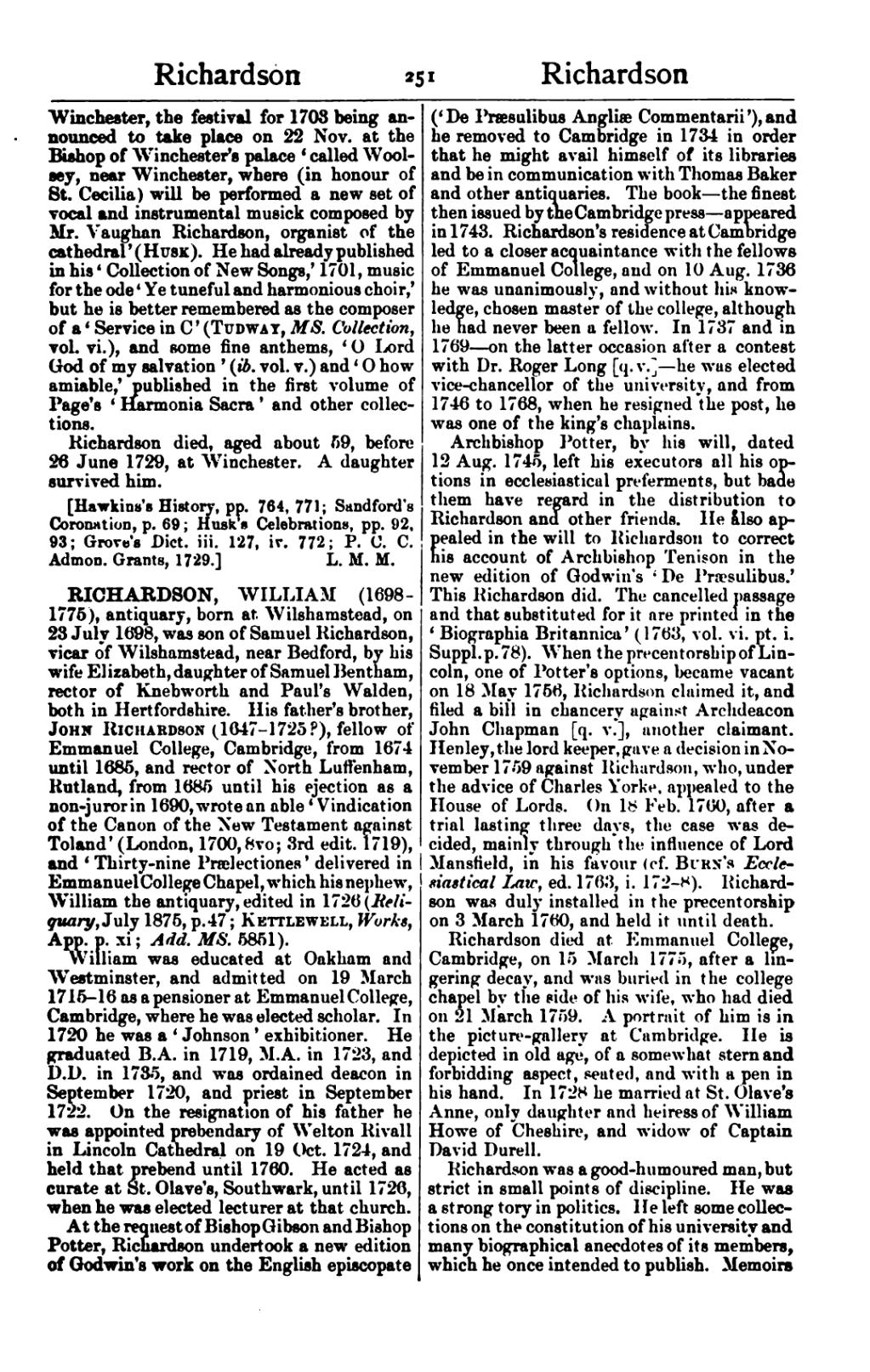Winchester, the festival for 1703 being announced to take place on 22 Nov. at the Bishop of Winchester's palace ‘called Woolsey, near Winchester, where (in honour of St. Cecilia) will be performed a new set of vocal and instrumental musick composed by Mr. Vaughan Richardson, organist of the cathedral’ (Husk). He had already published in his ‘Collection of New Songs,’ 1701, music for the ode ‘Ye tuneful and harmonious choir,’ but he is better remembered as the composer of a ‘Service in C’ (Tudway, MS. Collection, vol. vi.), and some fine anthems, ‘O Lord God of my salvation’ (ib. vol. v.) and ‘O how amiable,’ published in the first volume of Page's ‘Harmonia Sacra’ and other collections.
Richardson died, aged about 59, before 26 June 1729, at Winchester. A daughter survived him.
[Hawkins's History, pp. 764, 771; Sandford's Coronation, p. 69; Husk's Celebrations, pp. 92, 93; Grove's Dict. iii. 127, iv. 772; P. C. C. Admon, Grants, 1729.]
RICHARDSON, WILLIAM (1698–1775), antiquary, born at Wilshamstead, on 23 July 1698, was son of Samuel Richardson, vicar of Wilshamstead, near Bedford, by his wife Elizabeth, daughter of Samuel Bentham, rector of Knebworth and Paul's Walden, both in Hertfordshire. His father's brother, John Richardson (1647–1725?), fellow of Emmanuel College, Cambridge, from 1674 until 1685, and rector of North Luffenham, Rutland, from 1685 until his ejection as a non-juror in 1690, wrote an able ‘Vindication of the Canon of the New Testament against Toland’ (London, 1700, 8vo; 3rd edit. 1719), and ‘Thirty-nine Prælectiones’ delivered in Emmanuel College Chapel, which his nephew, William the antiquary, edited in 1726 (Reliquary, July 1875, p. 47; Kettlewell, Works, App. p. xi; Add. MS. 5851).
William was educated at Oakham and Westminster, and admitted on 19 March 1715–16 as a pensioner at Emmanuel College, Cambridge, where he was elected scholar. In 1720 he was a ‘Johnson’ exhibitioner. He graduated B.A. in 1719, M.A. in 1723, and D.D. in 1735, and was ordained deacon in September 1720, and priest in September 1722. On the resignation of his father he was appointed prebendary of Welton Rivall in Lincoln Cathedral on 19 Oct. 1724, and held that prebend until 1760. He acted as curate at St. Olave's, Southwark, until 1726, when he was elected lecturer at that church.
At the request of Bishop Gibson and Bishop Potter, Richardson undertook a new edition of Godwin's work on the English episcopate (‘De Præsulibus Angliæ Commentarii’), and he removed to Cambridge in 1734 in order that he might avail himself of its libraries and be in communication with Thomas Baker and other antiquaries. The book—the finest then issued by the Cambridge press—appeared in 1743. Richardson's residence at Cambridge led to a closer acquaintance with the fellows of Emmanuel College, and on 10 Aug. 1736 he was unanimously, and without his knowledge, chosen master of the college, although he had never been a fellow. In 1737 and in 1769—on the latter occasion after a contest with Dr. Roger Long [q. v.]—he was elected vice-chancellor of the university, and from 1746 to 1768, when he resigned the post, he was one of the king's chaplains.
Archbishop Potter, by his will, dated 12 Aug. 1745, left his executors all his options in ecclesiastical preferments, but bade them have regard in the distribution to Richardson and other friends. He also appealed in the will to Richardson to correct his account of Archbishop Tenison in the new edition of Godwin's ‘De Præsulibus.’ This Richardson did. The cancelled passage and that substituted for it are printed in the ‘Biographia Britannica’ (1763, vol. vi. pt. i. Suppl. p. 78). When the precentorship of Lincoln, one of Potter's options, became vacant on 18 May 1756, Richardson claimed it, and filed a bill in chancery against Archdeacon John Chapman [q. v.], another claimant. Henley, the lord keeper, gave a decision in November 1759 against Richardson, who, under the advice of Charles Yorke, appealed to the House of Lords. On 18 Feb. 1760, after a trial lasting three days, the case was decided, mainly through the influence of Lord Mansfield, in his favour (cf. Burn's Ecclesiastical Law, ed. 1763, i. 172–8). Richardson was duly installed in the precentorship on 3 March 1760, and held it until death.
Richardson died at Emmanuel College, Cambridge, on 15 March 1775, after a lingering decay, and was buried in the college chapel by the side of his wife, who had died on 21 March 1759. A portrait of him is in the picture-gallery at Cambridge. He is depicted in old age, of a somewhat stern and forbidding aspect, seated, and with a pen in his hand. In 1728 he married at St. Olave's Anne, only daughter and heiress of William Howe of Cheshire, and widow of Captain David Durell.
Richardson was a good-humoured man, but strict in small points of discipline. He was a strong tory in politics. He left some collections on the constitution of his university and many biographical anecdotes of its members, which he once intended to publish. Memoirs
